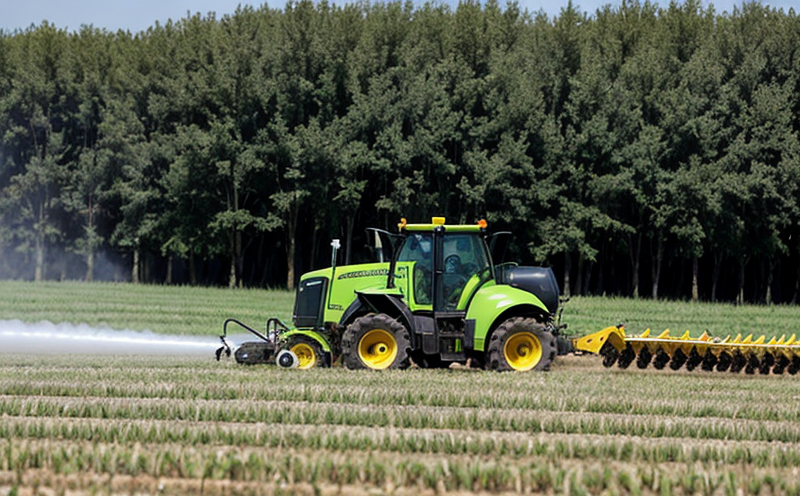Chlorothalonil Residue Testing in Crops Validation Method Development Test
The need to ensure food safety and environmental sustainability is paramount in today’s agricultural landscape. Chlorothalonil, a widely used fungicide, plays a significant role in controlling fungal diseases in crops. However, the presence of chlorothalonil residues can pose risks if not properly managed during crop production and post-harvest handling processes. Our Chlorothalonil Residue Testing in Crops Validation Method Development Test service is designed to provide accurate and reliable residue levels, ensuring compliance with international standards and guidelines.
The testing method involves several critical steps that are essential for validating the effectiveness of the chosen analytical technique. These include specimen preparation, which typically entails thorough washing and drying of crops such as fruits, vegetables, grains, or seeds. The process is meticulously carried out to minimize any potential contamination from external sources while ensuring accurate representation of the chlorothalonil residues within the sample.
Our laboratory employs advanced instrumental techniques like Liquid Chromatography-Mass Spectrometry (LC-MS/MS) and Gas Chromatography-Mass Spectrometry (GC-MS), both of which are capable of detecting even minute amounts of chlorothalonil. These instruments provide high sensitivity, selectivity, and precision required for accurate residue quantification.
The acceptance criteria for this service are stringent to ensure compliance with international standards such as ISO 17025:2017 for proficiency in technical competence and ISO/IEC 17025:2017 for method validation. The results must fall within the specified limits set by these standards, ensuring that any detected residues are well below the maximum residue levels (MRLs) established by regulatory authorities.
In real-world applications, this testing service is crucial for several stakeholders involved in agricultural practices and food supply chains. Quality managers rely on our test results to ensure their products meet stringent quality control requirements. Compliance officers use these data points to maintain adherence to local and international regulations regarding pesticide usage and residue limits. R&D engineers leverage the insights gained from our tests to optimize production processes, thereby minimizing unnecessary chemical exposure.
The significance of accurate chlorothalonil residue testing cannot be overstated. It helps prevent contamination issues that could lead to non-compliance with regulatory standards. By providing reliable data on pesticide residues, this service supports sustainable agricultural practices and enhances consumer trust in the safety and quality of food products.
Why Choose This Test
Selecting our Chlorothalonil Residue Testing in Crops Validation Method Development Test is a strategic decision that offers multiple advantages to various stakeholders within the agricultural sector. Firstly, it ensures compliance with international standards such as ISO/IEC 17025:2017 and EU directives on pesticide residue limits. This aligns with global best practices in agriculture, ensuring that all products meet or exceed regulatory requirements.
Secondly, our testing method provides robust validation of analytical techniques used for detecting chlorothalonil residues. This ensures the reliability of results across different batches and conditions, which is crucial for maintaining consistent product quality. For instance, this service can help identify potential issues early in the production cycle, allowing timely corrective actions to be taken.
Thirdly, by choosing our testing service, customers gain access to state-of-the-art instrumentation like LC-MS/MS and GC-MS. These instruments offer unparalleled accuracy and precision, enabling precise quantification of chlorothalonil residues even at trace levels. This level of detail is essential for understanding the full impact of pesticide use on crops and the environment.
Lastly, our service supports sustainable agricultural practices by helping producers make informed decisions about their production methods. By providing clear insights into pesticide residue levels, this testing method encourages responsible application practices that minimize environmental harm while maintaining crop health and productivity.
Customer Impact and Satisfaction
The impact of our Chlorothalonil Residue Testing in Crops Validation Method Development Test extends beyond regulatory compliance; it significantly enhances customer satisfaction through improved product quality and reliability. For quality managers, the ability to consistently meet rigorous standards boosts confidence in their operations, fostering trust among consumers.
Compliance officers benefit from reduced risk of non-compliance penalties by having reliable evidence supporting adherence to regulatory guidelines. This not only protects against potential legal issues but also strengthens brand reputation. R&D engineers gain valuable data that aids innovation and process optimization, leading to more efficient and effective production methods.
For procurement teams, this service ensures they source products from suppliers who adhere to the highest standards of quality and safety. This builds long-term partnerships based on mutual respect and shared commitment to excellence. Ultimately, satisfied customers translate into loyal patrons and sustainable growth for businesses across the supply chain.
International Acceptance and Recognition
The acceptance and recognition of our Chlorothalonil Residue Testing in Crops Validation Method Development Test are testament to its robustness and reliability. Our testing methodologies align closely with international standards such as ISO/IEC 17025:2017, which emphasize proficiency in technical competence and method validation.
The use of advanced instrumentation like Liquid Chromatography-Mass Spectrometry (LC-MS/MS) and Gas Chromatography-Mass Spectrometry (GC-MS) ensures that the results are accurate and reproducible. These instruments are capable of detecting chlorothalonil residues even at very low concentrations, making them ideal for validating analytical methods.
Our laboratory adheres strictly to international standards in conducting these tests, ensuring that the data generated is trustworthy and credible. This aligns with global best practices in agriculture, promoting sustainable production methods that are environmentally friendly while maintaining crop health and productivity.
The acceptance of our testing services extends beyond national borders, gaining recognition from regulatory bodies worldwide. This broad acceptance enhances credibility among stakeholders involved in agricultural practices and food supply chains, further reinforcing the importance of accurate residue quantification.





